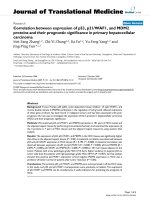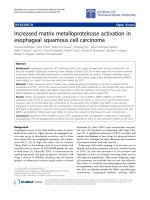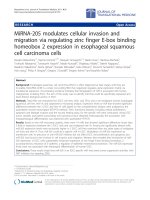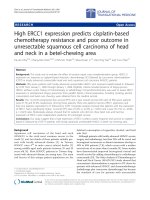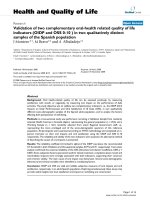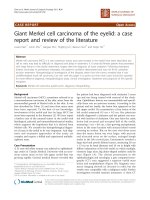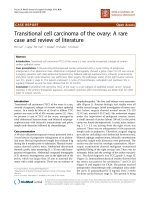Oncologic outcome and potential prognostic factors in primary squamous cell carcinoma of the parotid gland
Bạn đang xem bản rút gọn của tài liệu. Xem và tải ngay bản đầy đủ của tài liệu tại đây (659.21 KB, 6 trang )
Fang et al. BMC Cancer
(2019) 19:752
/>
RESEARCH ARTICLE
Open Access
Oncologic outcome and potential
prognostic factors in primary squamous cell
carcinoma of the parotid gland
Qigen Fang1* , Junfu Wu1 and Fei Liu2
Abstracts
Background: Primary parotid squamous cell carcinoma (SCC) is an uncommon tumour, and there is limited data
on its prognosis and treatment. The goal of the current study was to analyse the potential prognostic factors and
clinical outcomes for this tumour type.
Methods: Consecutive patients with surgically treated primary parotid SCC were retrospectively enrolled in this
study. The primary end point was locoregional control (LRC) and disease-specific survival (DSS), which were
calculated by the Kaplan-Meier method. Independent prognostic factors were evaluated by the Cox proportional
hazards method.
Results: In total, 53 patients were included for analysis. Perineural and lymphovascular invasion were observed in
21 and 16 patients, respectively. Intraparotid node (IPN) metastasis was reported in 23 patients with an incidence
rate of 43.3%. Twenty-six patients with cN0 disease underwent neck dissection, and pathologic node metastasis was
observed in 10 cases. The 5-year LRC and DS S rates were 35 and 49%, respectively. The Cox model was used to
report the independence of disease stage and IPN metastasis in predicting LRC and the independence of disease
stage and perineural invasion in predicting DSS.
Conclusions: The prognosis of primary parotid SCC is relatively unfavourable. IPN metastasis significantly decreases
disease control, disease stage is the most important prognostic factor, and neck dissection is suggested for patients
at any stage.
Keywords: Parotid cancer, Parotid squamous cell carcinoma, Intraparotid node metastasis, Prognosis analysis
Background
Parotid cancers account for 70% of all salivary gland malignancies, and there are 24 different types of malignancies [1–3], of which squamous cell carcinoma (SCC) is
one of the least common histologic subtypes. SCC usually conveys a poor 5-year survival rate of less than 50%
with an incidence varying from 0.1 to 10% in salivary
malignancies [4–10].
Owing to the extreme rarity of parotid SCC, very few
authors have focused on this cancer [4–14]. Many studies only describe demographic results, such as parotid
SCC being likely to occur in older male patients, but
* Correspondence:
1
Department of Head Neck and Thyroid, Affiliated Cancer Hospital of
Zhengzhou University, Henan Cancer Hospital, Zhengzhou, People’s Republic
of China
Full list of author information is available at the end of the article
detailed parotid prognostic factors and accurate survival
data are unknown [4–7]. All investigators agree that before a diagnosis of primary parotid SCC is confirmed,
metastatic SCC from other sites of the head and neck
and high grade mucoepidermoid carcinoma must be excluded [4–14]. Recently, two studies were published
based on the SEER database. Chen et al. [11] reported
that the 5-year DSS rates for patients with stage I, II, III,
and IV disease were 86.5, 78.1, 82.4, and 62.8%, respectively, and Pfisterer et al. [12] found that the 5-year DSS
rates for patients with stage I, II, III, and IV disease were
80.1, 72.5, 71.3, and 50.3%, respectively. However, these
two studies do not specifically identify primary disease
from metastatic parotid SCC. Primary parotid SCC
might have unique characteristics distinct from metastatic parotid SCC and other parotid cancers. Therefore,
© The Author(s). 2019 Open Access This article is distributed under the terms of the Creative Commons Attribution 4.0
International License ( which permits unrestricted use, distribution, and
reproduction in any medium, provided you give appropriate credit to the original author(s) and the source, provide a link to
the Creative Commons license, and indicate if changes were made. The Creative Commons Public Domain Dedication waiver
( applies to the data made available in this article, unless otherwise stated.
Fang et al. BMC Cancer
(2019) 19:752
the present study aimed to analyse the potential prognostic factors and clinical outcomes of this disease.
Page 2 of 6
Table 1 Descriptive characteristics of the enrolled patients
Variables
Number (%)
Sex
Methods
The Zhengzhou University institutional research committee approved our study, and all participants signed an
informed consent agreement for medical research before
initial treatment. All experiments were performed in accordance with the Declaration of Helsinki.
From January 2005 to December 2016, medical records
of patients with surgically treated parotid SCC were
reviewed. Enrolled patients had to meet the following criteria: no previous history of SCC of the head and neck;
pathological sections were re-reviewed to exclude the possibility of high grade mucoepidermoid carcinoma with the
help of mucin stains [3–9]; and patients had undergone a
PET-CT examination to exclude the possibility of metastatic disease. Data regarding age, sex, TNM stage based
on the AJCC 7th system, pathological reports, and followup were extracted by JF-W and analysed by QG-F, JF-W
and FL. Perineural invasion was considered to be present
if tumour cells were identified within the perineural space
and/or nerve bundle. Lymphovascular infiltration was
positive if a tumour was present within the lymphovascular channels [14].
The primary end point was locoregional control (LRC)
and disease-specific survival (DSS), which were calculated from the date of surgery to the date of event or
latest follow-up, respectively. The Kaplan-Meier approach was used to calculate the LRC and DSS rates,
and factors that were significant by univariate analysis
were then analysed by the multivariate proportional hazard Cox model to evaluate independent prognostic factors. All statistical analyses were performed by SPSS
20.0, and p < 0.05 was considered to be significant.
Results
In total, 53 (43 male and 10 female) patients with primary parotid SCC were included for analysis. The mean
age was 67.4 (range: 32–78) years. The tumour stages
were distributed as follows: T1 in 10 cases, T2 in 22
cases, T3 in 13 cases, and T4 in 8 cases. Superficial parotidectomy was performed in 18 patients, and total parotidectomy was performed in 35 cases. Perineural and
lymphovascular invasion were observed in 21 and 16 patients, respectively. Intraparotid node (IPN) metastasis
was observed in 23 patients with an incidence rate of
43.3%. Negative margins were achieved in 49 patients
(Table 1).
In 40 patients with cN0 disease, 26 cases underwent
neck dissection of level I-III, pathological neck metastasis was reported in 10 cases (Table 2), and extracapsular
spread was observed in 3 cases. Thirteen patients with
cN+ disease underwent neck dissection of level I-V, and
Male
43 (81.1%)
Female
10 (18.9%)
Operation extent
Superficial parotidectomy
18 (34.0%)
Total parotidectomy
35 (66.0%)
Tumor stage
T1
10 (18.9%)
T2
22 (41.5%)
T3
13 (24.5%)
T4
8 (15.1%)
Neck lymph node stage
N0
30 (56.6%)
N+
23 (43.4%)
Perineural invasion
21 (39.6%)
Lymphovascular invasion
16 (30.2%)
Intraparotid node metastasis
23 (43.3%)
Negative margin
49 (92.5%)
pathological neck metastasis was reported in all cases,
with extracapsular spread observed in 7 cases.
The mean follow-up time was 67.3 (range: 4–135)
months, 45 patients received adjuvant radiotherapy, and
16 cases underwent adjuvant chemotherapy. Locoregional
recurrence was observed in 35 patients: 10 cases locally,
14 cases regionally, and 11 cases with simultaneous local
and regional recurrence. Fourteen patients received
salvage surgery, and 21 patients underwent palliative
radiochemotherapy. Chemotherapy regimens were primarily based on docetaxel in combination with cisplatin.
The 5-year LRC rate was 35% (95%CI: 24–46%) (Fig. 1),
and most (68.6%, 24/35) recurrence occurred within 2
years after surgery. Univariate analysis (log-rank test) revealed that an advanced disease stage, extracapsular
spread, and IPN were associated with decreased LRC.
Further Cox modelling reported the independence of
disease stage (p < 0.001, 4.122[1.578–16.142]) and IPN
(p = 0.007, 2.347[1.279–5.612]) in predicting LRC
(Table 3).
A total of 27 patients died from the disease, and the 5year DSS was 49% (95%CI: 38–60%) (Fig. 2). Univariate
Table 2 Distribution of clinical stages in patients undergoing
neck dissection for cN0 disease
cN0 (n = 26)
cT1
cT2
cT3
cT4
pN0
4
8
2
2
pN+
2
3
2
3
Fang et al. BMC Cancer
(2019) 19:752
Page 3 of 6
Fig. 1 Locoregional control survival in patients with primary parotid
squamous cell carcinoma
analysis (log-rank test) revealed an advanced disease
stage, perineural invasion, and high tumour stage were
associated with decreased DSS. Further Cox modelling
revealed the independence of disease stage (p < 0.001,
5.956[1.875–17.324]) and perineural invasion (p = 0.004,
2.113[1.278–7.645]) in predicting DSS (Table 4).
Discussion
Primary parotid SCC has an aggressive clinical presentation, and most patients experienced disease recurrence
within 2 years after the initial treatment. The 5-year LRC
and DSS rates in the current study were only 35 and
49%, respectively. Flynn et al. [4] reported the oncologic
outcome of 8 cases, reporting that seven patients died of
the disease, with only 1 case being alive and free of
Fig. 2 Disease specific survival in patients with primary parotid
squamous cell carcinoma
disease. Lee et al. [5] retrospectively enrolled 12 patients
with primary parotid SCC and described the regional
and local failure rates as 25 and 58%, respectively. Similar findings were noted by Sterman et al. [6] and
Gaughan et al. [7]. However, these studies were limited
by a relatively small sample size. Recently, two studies
were published with large sample sizes focusing on parotid SCC based on the SEER database. Chen et al. [11]
reported that the 5-year DSS rates for patients with stage
I, II, III, and IV disease were 86.5, 78.1, 82.4, and 62.8%,
respectively, and Pfisterer et al. [12] found that the 5year DSS rates for patients with stage I, II, III, and IV
disease were 80.1, 72.5, 71.3, and 50.3%, respectively.
These survival data are slightly better than those reported in the present study, but these two studies did
Table 3 Prognostic factors for locoregional control in patients with primary parotid squamous cell carcinoma
Univariate analysis
Cox model
Log rank test
HR[95%CI]
p
4.122[1.578–16.142]
< 0.001
Age (< 67 vs ≥67)
0.541
Sex (Male vs female)
0.194
Tumor stage (T1 + T2 vs T3 + T4)
0.188
Node stage (N0 vs N+)
0.097
Disease stage (I + II vs III + IV)
0.008
a
Surgery (TP vs SP)
0.333
Perineural invasion
0.256
Lymphovascular invasion
0.142
Intraparotid node metastasis
0.027
Margin status
0.679
Adjuvant radiotherapy
0.147
Adjuvant chemotherapy
0.633
Extracapsular spread
0.014
: TP Total parotidectomy, SP Superficial parotidectomy
a
2.347[1.279–5.612]
0.007
3.841[0.946–8.445]
0.067
Fang et al. BMC Cancer
(2019) 19:752
Page 4 of 6
Table 4 Prognostic factors for disease specific survival in patients with primary parotid squamous cell carcinoma
Univariate analysis
Cox model
Log rank test
HR[95%CI]
Age (< 67 vs ≥67)
0.845
Sex (Male vs female)
0.416
Tumor stage (T1 + T2 vs T3 + T4)
0.031
Node stage (N0 vs N+)
0.154
Disease stage (I + II vs III + IV)
0.007
a
Surgery (TP vs SP)
0.362
Perineural invasion
0.019
Lymphovascular invasion
0.225
Intraparotid node metastasis
0.411
Margin status
0.632
Adjuvant radiotherapy
0.522
Adjuvant chemotherapy
0.146
Extracapsular spread
0.287
p
2.645[0.745–13.241]
0.144
5.956[1.875–17.324]
< 0.001
2.113[1.278–7.645]
0.004
: TP Total parotidectomy, SP Superficial parotidectomy
a
not specifically identify primary disease from metastatic
parotid SCC. Our outcome is more consistent with a report by Wang et al. [10], wherein 20 of 34 patients developed disease recurrence and 19 patients died, with a
5-year DSS rate of 50.3%.
Perineural and lymphovascular invasion, as well as
extracapsular spread, are well known adverse pathological
characteristics [15–18]. Walvekar et al. [7] reported that
high grade parotid cancer is more likely to exhibit extracapsular spread. Lee et al. [18] described that compared to
low grade parotid cancers, perineural and lymphovascular
invasion were more common in high grade malignancies.
SCC is recognized as one kind of high grade parotid
malignancy, but no studies have reported the detailed frequency of such adverse pathological characteristics. Unlike
parotid adenocarcinoma, parotid SCC might have unique
characteristics, including a higher likelihood of perineural
and lymphovascular invasion. Our findings support this
hypothesis, and incidences were slightly higher than those
previously reported [19–21].
Neck lymph node metastasis is an important prognostic factor in head and neck cancer [22–25], but the role
of elective neck dissection on cN0 parotid cancer remains controversial. A common principle is that N0
necks should be electively treated when the occult metastatic rate is greater than 20% [26]. Ali et al. [27] studied
263 patients at Memorial Sloan-Kettering Cancer Center
and concluded that in patients with cN0 disease, observation of the neck was safe in those under 60 years of
age with clinical T1 or T2 tumours who had low-grade
histology. END should be performed in patients with
cT3T4 disease or high-grade histology and should involve levels II to IV at a minimum. Armstrong et al. [28]
retrospectively reported that overall occult lymph node
metastasis occurred in 12% of 474 salivary gland cancer
patients, and multivariate analysis demonstrated a positive association between pathological tumour grade and
risk of occult metastasis. The authors subsequently concluded that END should be reserved for high grade
tumours and for those with larger primary tumours.
This viewpoint was also supported by other investigators
[29, 30]. In the current study, we found that the rate of
occult neck metastasis was 27.8% for early stage parotid
SCC, while previous authors described a variable occult
metastasis rate from 41 to 60% [8]. These findings all
suggest the necessity of routine neck dissection for treating primary parotid SCC, even in early stage disease.
The prognostic factors for parotid cancer have been
widely analysed. Accepted survival predictors include
high tumour stage, neck lymph node metastasis, perineural invasion, lymphovascular invasion, pathological
tumour grade, neutrophil-to-lymphocyte ratio, resection
margin, and intraparotid node metastasis [1, 3, 22–24].
Niu et al. [23] retrospectively enrolled 35 patients with
sarcomatoid carcinoma in the parotid gland, concluding
that perineural invasion was the most important predictive factor. Chang et al. [24] analysed the oncologic outcome in 98 patients with primary parotid cancer and
found that the pathological T stage, resection margin,
external parenchymal extension, pathological lymph
node status, and maximum standardized uptake value
were significantly related to DSS by univariate analysis.
Further Cox modelling revealed that the pathological
lymph node status and maximum standardized uptake
values were independent prognostic factors. Similar findings were also observed in the current study. However,
we noted that there was a relatively high rate of IPN metastasis and that, interestingly, IPN metastasis was
Fang et al. BMC Cancer
(2019) 19:752
associated with a higher recurrence risk. The association
between IPN metastasis and prognosis in parotid cancer
has rarely been evaluated. Lim et al. [25] simply described that IPN metastasis was related to poor disease
control. Feng et al. [19] previously reported that IPN
metastasis was associated with poor local control and
that metastatic IPNs conveyed a worse prognosis. A possible explanation might be that there are lymph nodes in
both lobes of the parotid gland and that positive deep
lymph nodes might remain after superficial or lateral
parotidectomy. Furthermore, residual disease might be
present, and recurrent disease was expected.
Key limitations in this study must be acknowledged. Although this population was representative, it is difficult to
draw firm conclusions regarding the clinical importance of
IPN metastasis and routine neck dissection. However, these
findings indicated that the accurate role of IPN metastasis
in prognosis deserves additional and larger prospective
studies. Second, the sample size was relatively small, and
additional large sample sizes or multicentre studies are
needed to clarify these questions.
Conclusions
In summary, the prognosis of primary parotid SCC is
relatively unfavourable, and IPN metastasis significantly
decreases disease control. Furthermore, disease stage is
the most important prognostic factor, and neck dissection is suggested for any stage patient.
Abbreviations
DSS: Disease-specific survival; IPN: Intraparotid node; LRC: Locoregional
control; SCC: Squamous cell carcinoma
Acknowledgments
We are grateful for pathological section review from the pathology
department.
Authors’ contributions
Study design and manuscript writing: FQG, WJF, and LF. Study selection and
data analysis: FQG, WJF, and LF. Study quality evaluation: FQG, WJF, and LF.
Manuscript revision: FQG, WJF, and LF. All the authors have read and
approved the final manuscript.
Funding
None declared.
Availability of data and materials
All data generated or analysed during this study are included in this
published article. The primary data can be received from the corresponding
author.
Ethics approval and consent to participate
The Zhengzhou University institutional research committee approved our
study, and all participants signed an informed consent agreement for
medical research before initial treatment. All related procedures were
consistent with Ethics Committee regulations.
Consent for publication
Not applicable.
Competing interests
The authors declare that they have no competing interests.
Page 5 of 6
Author details
1
Department of Head Neck and Thyroid, Affiliated Cancer Hospital of
Zhengzhou University, Henan Cancer Hospital, Zhengzhou, People’s Republic
of China. 2Department of Oral Medicine, The First affiliated hospital of
Zhengzhou University, Zhengzhou, People’s Republic of China.
Received: 14 March 2019 Accepted: 22 July 2019
References
1. Fang Q, Liu F, Seng D. Oncologic outcome of parotid mucoepidermoid
carcinoma in paediatric patients. Cancer Manag Res. 2019;11:1081–5.
2. Gao M, Hao Y, Huang MX, Ma DQ, Chen Y, Luo HY, Gao Y, Cao ZQ,
Peng X, Yu GY. Salivary gland tumours in a northern Chinese
population: a 50-year retrospective study of 7190 cases. Int J Oral
Maxillofac Surg. 2017;46:343–9.
3. Niu X, Liu F, Fang Q. Role of intraparotid node metastasis in
mucoepidermoid carcinoma of the parotid gland. BMC Cancer. 2019;19:417.
4. Flynn MB, Maguire S, Martinez S, Tesmer T. Primary squamous cell
carcinoma of the parotid gland: the importance of correct histological
diagnosis. Ann Surg Oncol. 1999;6:768–70.
5. Lee S, Kim GE, Park CS, Choi EC, Yang WI, Lee CG, Keum KC, Kim YB, Suh
CO. Primary squamous cell carcinoma of the parotid gland. Am J
Otolaryngol. 2001;22:400–6.
6. Sterman BM, Kraus DH, Sebek BA, Tucker HM. Primary squamous cell
carcinoma of the parotid gland. Laryngoscope. 1990;100:146–8.
7. Gaughan RK, Olsen KD, Lewis JE. Primary squamous cell carcinoma of the
parotid gland. Arch Otolaryngol Head Neck Surg. 1992;118:798–801.
8. Ying YL, Johnson JT, Myers EN. Squamous cell carcinoma of the parotid
gland. Head Neck. 2006;28:626–32.
9. Akhtar K, Ray PS, Sherwani R, Siddiqui S. Primary squamous cell carcinoma
of the parotid gland: a rare entity. BMJ Case Rep. 2013;2013.
10. Wang L, Li H, Yang Z, Chen W, Zhang Q. Outcomes of primary squamous
cell carcinoma of major salivary glands treated by surgery with or without
postoperative radiotherapy. J Oral Maxillofac Surg. 2015;73:1860–4.
11. Chen MM, Roman SA, Sosa JA, Judson BL. Prognostic factors for
squamous cell cancer of the parotid gland: an analysis of 2104 patients.
Head Neck. 2015;37:1–7.
12. Pfisterer MJ, Vazquez A, Mady LJ, Khan MN, Baredes S, Eloy JA. Squamous
cell carcinoma of the parotid gland: a population-based analysis of 2545
cases. Am J Otolaryngol. 2014;35:469–75.
13. Cheraghlou S, Schettino A, Zogg CK, Otremba MD, Bhatia A, Park HS,
Osborn HA, Mehra S, Yarbrough WG, Judson BL. Adjuvant chemotherapy is
associated with improved survival for late-stage salivary squamous cell
carcinoma. Laryngoscope. 2018. />14. Skulsky SL, O'Sullivan B, McArdle O, Leader M, Roche M, Conlon PJ, O'Neill
JP. Review of high-risk features of cutaneous squamous cell carcinoma and
discrepancies between the American joint committee on Cancer and NCCN
clinical practice guidelines in oncology. Head Neck. 2017;39:578–94.
15. Ning C, Zhao T, Wang Z, Li D, Kou Y, Huang S. Cervical lymph node
metastases in salivary gland adenoid cystic carcinoma: a systematic review
and meta-analysis. Cancer Manag Res. 2018;10:1677–85.
16. Shi X, Huang NS, Shi RL, Wei WJ, Wang YL, Ji QH. Prognostic value of
primary tumor surgery in minor salivary-gland carcinoma patients with
distant metastases at diagnosis: first evidence from a SEER-based study.
Cancer Manag Res. 2018;10:2163–72.
17. Walvekar RR, Filho PAA, Seethala RR, Gooding WE, Heron DE, Johnson JT,
Ferris RL. Clinicopathologic features as stronger prognostic factors than
histology or grade in risk stratification of primary parotid malignancies.
Head Neck. 2011;33:225–31.
18. Lee DY, Park MW, Oh KH, Cho JG, Kwon SY, Woo JS, Jung KY, Baek SK.
Clinicopathologic factors associated with recurrence in low- and high-grade
parotid cancers. Head Neck. 2016;38(Suppl 1):E1788–93.
19. Feng Y, Liu F, Cheng G, Fang Q, Niu X, He W. Significance of intraparotid
node metastasis in predicting local control in primary parotid cancer.
Laryngoscope. 2018. />20. Shang X, Fang Q, Liu F, Wu J, Luo R, Qi J. Deep parotid lymph node
metastasis is associated with recurrence in high-grade mucoepidermoid
carcinoma of the parotid gland. J Oral Maxillofac Surg. 2019. https://doi.
org/10.1016/j.joms.2019.01.031.
Fang et al. BMC Cancer
(2019) 19:752
21. Huang AT, Tang C, Bell D, Yener M, Izquierdo L, Frank SJ, El-Naggar AK,
Hanna EY, Weber RS, Kupferman ME. Prognostic factors in adenocarcinoma
of the salivary glands. Oral Oncol. 2015;51:610–5.
22. Di L, Qian K, Du C, Shen C, Zhai R, He X, Wang X, Xu T, Hu C, Ying H.
Radiotherapy as salvage treatment of salivary duct carcinoma in major
salivary glands without radical operations. Cancer Manag Res. 2018;10:
6071–8.
23. Niu X. Sarcomatoid carcinoma in the parotid gland: a review of 30 years of
experience. Laryngoscope. 2018. />24. Chang JW, Hong HJ, Ban MJ, Shin YS, Kim WS, Koh YW, Choi EC. Prognostic
factors and treatment outcomes of parotid gland cancer: a 10-year singlecenter experience. Otolaryngol Head Neck Surg. 2015;153:981–9.
25. Lim CM, Gilbert MR, Johnson JT, Kim S. Clinical significance of
intraparotid lymph node metastasis in primary parotid cancer. Head
Neck. 2014;36:1634–7.
26. Weiss MH, Harrison LB, Isaacs RS. Use of decision analysis in planning a
management strategy for the stage N0 neck. Arch Otolaryngol Head Neck
Surg. 1994;120:699–702.
27. Ali S, Palmer FL, DiLorenzo M, Shah JP, Patel SG, Ganly I. Treatment of the
neck in carcinoma of the parotid gland. Ann Surg Oncol. 2014;21:3042–8.
28. Armstrong JG, Harrison LB, Thaler HT, Friedlander-Klar H, Fass DE, Zelefsky
MJ, Shah JP, Strong EW, Spiro RH. The indications for elective treatment of
the neck in cancer of the major salivary glands. Cancer. 1992;69:615–9.
29. Moss WJ, Coffey CS, Brumund KT, Weisman RA. What is the role of elective
neck dissection in low-, intermediate-, and high-grade mucoepidermoid
carcinoma? Laryngoscope. 2016;126:11–3.
30. Fang Q, Wu J, Du W, Zhang X. Predictors of distant metastasis in parotid
acinic cell carcinoma. BMC Cancer. 2019;19:475.
Publisher’s Note
Springer Nature remains neutral with regard to jurisdictional claims in
published maps and institutional affiliations.
Page 6 of 6

